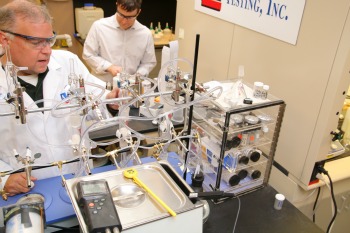 There are many reasons why chemical analyses are performed in the construction industry. Our clients, for instance, request these tests for a range of purposes—from simply meeting a specification requirement to litigation support.
There are many reasons why chemical analyses are performed in the construction industry. Our clients, for instance, request these tests for a range of purposes—from simply meeting a specification requirement to litigation support.
If you’re requesting a standard test from your chemical laboratory, communication is critical. Not being on the same page from the start can lead to cost overruns, delays, and inaccurate results. To prevent this from happening to your project, consider the following.
1. When it comes to the test method, be specific
When you are in need of a standard test, you will likely call your lab and ask for a specific test method. There are many similar-sounding test methods; not all will provide the same result so it’s important to be specific about your need. Some terms can sound almost identical, like nitrite and nitrate, alkalis and alkalinity; some are closely related, such as density and specific gravity. By specifying the specific test method, you can prevent any variability on results related to different test procedures.
Instead of a request for “chloride analysis,” be specific: “Perform ASTM C1152 acid soluble chloride.” With this level of specificity, your lab will know exactly what is being requested and the scope will be defined. AET can help you establish a matrix of different methods and sample types which would show the procedural variability. These documents can then be included with the samples you submit to the lab.
2. Include a copy of the specification, if applicable
Keep in mind that not all specifications are clearly written or understood. When a specification does not specify a test method, it’s easy to unknowingly request the wrong method. Different test methods, of course, may yield different results and/or affect interpretation of the results. If you’re not entirely certain of a test method, submit a copy of the specification prior to or along with your samples. While your lab won’t stipulate the type of test required, they can offer support to help interpret what is needed.
3. Document the agreed-upon test method
Once there is an agreed upon type of test method needed, be sure to document the agreement. By doing so, you will be certain that both of you are clear on what is to be performed, the costs that will be accrued, and the expected turnaround time. This documentation could be in the form of a quote or in a confirmation sent by email or letter.
4. Consult your lab before sampling materials
Consult your lab before making decisions about the number of samples to collect, the location from which they will be collected, and how they should be collected and treated prior to submittal. Background control materials are needed for some requests; your lab can assist on determining the appropriate materials for this function.
5. Tell your lab how test results will be used
For many types of tests, it’s important to know how the results will be used. Chloride analysis is one such test. For acceptance testing or evaluation of corrosion potential, specifications are often listed by “weight of cementitious.” Certain test methods, however, provide a “weight of mass” determination. If you aren’t aware of the differences, interpretation error can occur.
Furthermore, certain methods may not dictate the basis on which results should be reported. For example, results may be reported on an as-is basis, a dry-weight basis or an ignited-weight basis. Dry-weight basis is often used to make sure samples that have ambient amounts of moisture can be compared on an even basis. Ignited-weight basis means the samples have been heated at an elevated temperature; this is often done during fusion for X-Ray Fluorescence (XRF) analysis (portland cement is primarily reported on an ignited basis). An XRF analysis will be reported on either an as-is, dry-weight or ignited-weight basis; different needs dictate how it is reported. Including this information in your request will minimize editorial alterations on the report.
6. Use best practices when submitting samples
When submitting samples to a lab, be sure they are properly identified. It is always a good idea to include a list naming the samples to be tested. This allows the lab to be certain there aren’t any missing samples. If a sample is unaccounted for, this can be addressed early in the testing as opposed to after the results are delivered.
For certain tests, such as those that analyze chemical admixtures for physical and chemical uniformity (ASTM C494), be sure to include the (material) safety data sheets. If early on in the testing the lab finds that a submitted admixture is not conforming due to submission error, long-term testing can be stopped and restarted when conforming materials are obtained. This alone can reduce necessary reruns by months.
Before you seal the package ensure samples are labeled. Labs receive many samples; an unlabeled box can significantly delay turnaround. For more on best sample-submission practices, read this article I co-authored for the Spring 2014 American Edge.
7. Communicate, Communicate, Communicate
The proper protocols and tips we’ve covered boil down to one thing: communication. Having a conversation with your lab professional, being specific about your needs, and remaining diligent with your correspondence is key to getting the results you need. In the end, better communication leads to minimized costs, quicker turnaround times, and maximum quality and accuracy.
– Bill Rebel
For more information on AET’s Chemistry services please visit our service page or contact Bill. He may be reached at brebel@amengtest.com.

